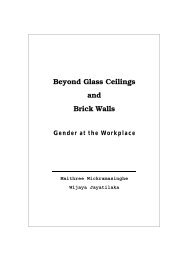SETP No. 14 The Economic Value of Incremental Employment in the ...
SETP No. 14 The Economic Value of Incremental Employment in the ...
SETP No. 14 The Economic Value of Incremental Employment in the ...
You also want an ePaper? Increase the reach of your titles
YUMPU automatically turns print PDFs into web optimized ePapers that Google loves.
7.9 Table 7.3 estimates <strong>the</strong> cost <strong>of</strong> earthwork excavation us<strong>in</strong>g labour-based<br />
techniques under vary<strong>in</strong>g soil conditions (and hence productivity levels), different<br />
wage rates, supervision and tool costs. <strong>The</strong> table is arranged so that low wages<br />
are coupled with low supervision and tool costs while higher wages are coupled<br />
with higher supervision costs. This is done to allow us to estimate possible<br />
highest and lowest costs, not because <strong>of</strong> any assumed relationship.<br />
Table 7-3<br />
<strong>The</strong> Cost <strong>of</strong> Earthwork Excavation us<strong>in</strong>g labour based methods<br />
Vary<strong>in</strong>g costs and ground conditions<br />
Assumptions<br />
Costs<br />
Rands<br />
Daily wage 1 25 33 50<br />
Daily cost <strong>of</strong> supervision per 20 workers 2 40 50 76<br />
Monthly cost <strong>of</strong> tools per worker 3 10 25 50<br />
Labour productivity M3 per day 4<br />
S<strong>of</strong>t Ground 5.0 5.0 5.0<br />
<strong>No</strong>rmal Ground 3.0 3.0 3.0<br />
Hard Ground 1.5 1.5 1.5<br />
Estimated cost per M3 <strong>of</strong> earthwork excavation<br />
Rands<br />
S<strong>of</strong>t Ground 5.5 7.3 11.2<br />
<strong>No</strong>rmal Ground 9.2 12.2 18.7<br />
Hard Ground 18.3 24.4 37.4<br />
<strong>No</strong>tes: 1. More than half <strong>the</strong> public works projects <strong>in</strong> <strong>the</strong> Western Cape paid daily wages between R20 and R30<br />
as determ<strong>in</strong>ed as part <strong>of</strong> <strong>the</strong> SALDRU (1999) study. Unpublished data.. R33.20 is <strong>the</strong> m<strong>in</strong>umum<br />
statutory wage for civil eng<strong>in</strong>eer<strong>in</strong>g <strong>in</strong> <strong>No</strong>r<strong>the</strong>rn Prov<strong>in</strong>ce (based on an 8 hour day)<br />
2. Taylor & Bekabye 1999 p<strong>14</strong> <strong>in</strong>dicate that supervision <strong>of</strong> labour based projects <strong>in</strong> Uganda costs 3.4% <strong>of</strong> project<br />
budget. At <strong>the</strong> same time labour cost 44.4% <strong>of</strong> project budger. Hence supevision was 7.6% <strong>of</strong> labour cost.<br />
At R25 per day this translates <strong>in</strong>to R38 per day, at R33 this equals R50 supervision and at R50 wage R76.<br />
3. Guestimate<br />
4. Average productivity rates as determ<strong>in</strong>ed by McCutcheon (1991) and<br />
Namibia, M<strong>in</strong>istry <strong>of</strong> Works, Transport and Communication (2000) vol. 2<br />
Table E.8 (draft report)<br />
7.10 Three different daily wages were chosen – a social m<strong>in</strong>imum, a statutory<br />
m<strong>in</strong>imum and an urban/peri-urban wage. SALDRU recently completed an<br />
<strong>in</strong>vestigation <strong>in</strong>to public works programmes <strong>in</strong> <strong>the</strong> Western Cape (SALDRU<br />
1999). Unpublished data on wages from <strong>the</strong> SALDRU study has been released<br />
for <strong>the</strong> purposes <strong>of</strong> this <strong>in</strong>vestigation. SALDRU <strong>in</strong>vestigated 101 projects. Of<br />
<strong>the</strong>se eleven paid R15 or less per day; thirty five paid between R16 and R29 and<br />
thirty three paid R30 a day. In o<strong>the</strong>r words, over 78% <strong>of</strong> public works projects<br />
<strong>in</strong>vestigated <strong>in</strong> <strong>the</strong> Western Cape paid daily wages <strong>of</strong> R 30 or less. <strong>The</strong> statutory<br />
m<strong>in</strong>imum wage chose here is for <strong>the</strong> <strong>No</strong>r<strong>the</strong>rn Prov<strong>in</strong>ce.<br />
• Under good soil conditions where construction labour earns R25 a day<br />
and <strong>the</strong>re are low supervision and tool costs, it costs R5.6m 3 for earthwork<br />
excavation. As <strong>the</strong> wage rate and o<strong>the</strong>r costs <strong>in</strong>creases so <strong>the</strong> cost <strong>of</strong><br />
mov<strong>in</strong>g soil <strong>in</strong>creases to R7.6 m 3 with a wage <strong>of</strong> R33 a day and R11.5 m 3<br />
for a daily wage <strong>of</strong> R50 and high supervision and tool costs.<br />
• Under normal work<strong>in</strong>g condition – daily wages <strong>of</strong> R33 result <strong>in</strong> costs <strong>of</strong><br />
mov<strong>in</strong>g soil <strong>of</strong> R9.3m 3 . With higher wages and associated costs <strong>the</strong><br />
extraction costs <strong>in</strong>crease to R12.7m 3 and R19.1 m 3 respectively.<br />
51
















